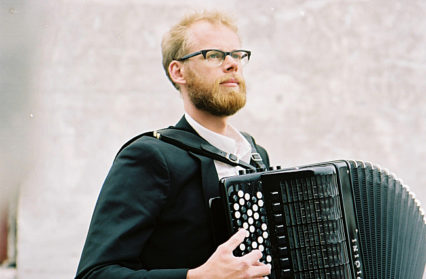BayArt Gallery, Cardiff Bay, 13th May 2016
Andreas Borregaard (accordion)
Quatuor Tana
Bent Sørensen: Looking on Darkness (2000)
Mark David Boden: String Quartet – Forgotten Time (2016) (World Premiere)
Magnus Lindberg: Jeux d’anches (1990)
David Hudry: Anamorphosis – Fragments (2016) (World Premiere)
Artist Andy Black’s black and white wall drawings of imaginary landscapes in Cardiff’s BayArt Galley provided an appropriate backdrop for a lunchtime concert of music which variously evoked and played off visual imagery.
Danish accordionist Andreas Borregaard sprang elfin-like onto the stage and, in his concentrated stillness before drawing sound from his instrument, created an atmosphere of taut excitement about the music we were gathered to hear in this new Vale of Glamorgan Festival venue. Fellow Dane Bent Sørensen took the title for his composition Looking on Darkness from Shakespeare’s Sonnet No. 27, in which the poet is kept from sleep by thoughts of his absent and possibly lost love. The mood of the sonnet is melancholic. Similarly the music, but it is a melancholy suffused with beauty. The opening melody and rattle of the pearlescent accordion buttons called to my mind the lapping of waters on the stones of a northern seashore. This image remained with me throughout the piece as the music ebbed and flowed, the small sighs of the waves joined by the deeper sighing of what could have been a bull walrus somewhere out to sea. At the end of the piece the opening motif returned in fragmentary form and finally gave way to a silence embued with all that had gone before.

Welsh composer Mark David Boden’s first string quartet, Forgotten Time, was a commission from the Vale of Glamorgan Festival, and was here given its world premiere by Belgium-based Quatuor Tana, playing with style and verve. The composer said in his programme note that he had, while writing the music, recalled ‘various anecdotes and experiences from the early years of my life’ and explored some of these in the quartet. From the ghostly opening through to sections of driving motor rhythms to lyricism and back, the composer expresses something personal to him but which also, in its guileless honesty and comfortingly familiar musical language, speaks to us all about the roller-coaster of emotions that is youth.
Andreas Borregaard returned to play Finnish composer Magnus Lindberg’s Jeux d’anches, which means ‘reed stops’ as in an organ. In a programme note for a previous performance of the piece, Lindberg said that as the accordion produces sound through metal tabs activated by a current of air, he feels he is composing for wind instruments. Indeed, the accordion is both a keyboard instrument and a reed instrument, and in his performance of this piece Borregaard brought out the astonishingly wide range of its sonorities. As I listened my eye was drawn to Andy Black’s fantastical visual landscape which acquired in this context the nature of a windy city, through which I was blown and whirled by the music.
The concluding work was French composer David Hudry’s Anamorphosis – Fragments. This is a work in progress which, in further projected performances later this year by Quatuor Tana, will incorporate electronics. Of the four composers represented in this concert David Hudry is the one who draws most directly and explicitly from visual images, here specifically from anamorphoses which, depending on the angle of view, may appear normal or distorted. He describes this work as being ‘about energy of rhythm and pulse, tension of diverging and conflicting lines, and surface density.’ It was certainly music full of energy and tension, from which an internal logic emerged, although for me the performance was over suddenly and too soon, before it could transform in ways which the finished work will, I hope, include.
The light spaces and warm acoustic of the gallery proved a fine venue for a delightful concert of fresh sounds, with the combination of alternating pieces for accordion and string quartet an inspired programming choice. To have, in the space of an hour, two world premieres for string quartet together with music for the accordion which reveals the breadth and depth of sound of which it is capable was remarkable. Furthermore we were treated to exquisite playing from all five performers and were also able to give their deserved applause to the composers of the new works, present for the occasion and both clearly moved by it.
Header photo of Andreas Borregaard, credit Caroline Bittencourt



 Enjoyed this article? Support our writers directly by buying them a coffee and clicking this link.
Enjoyed this article? Support our writers directly by buying them a coffee and clicking this link.







